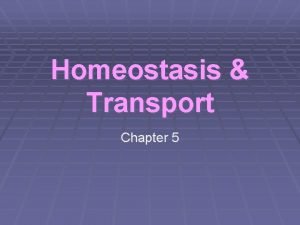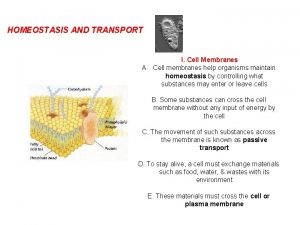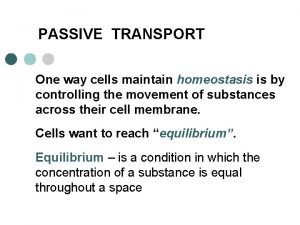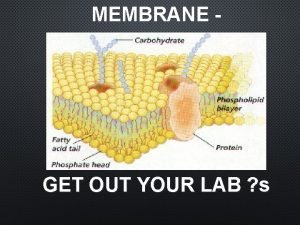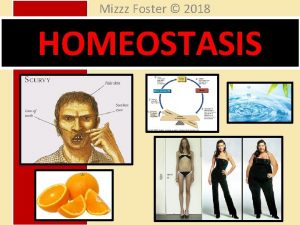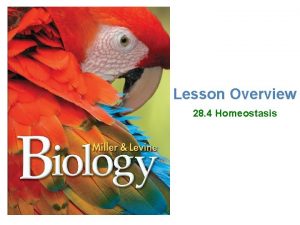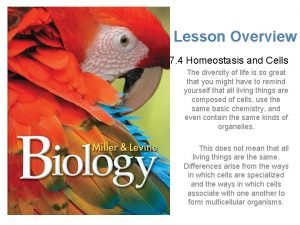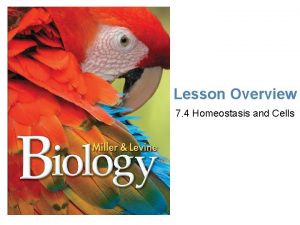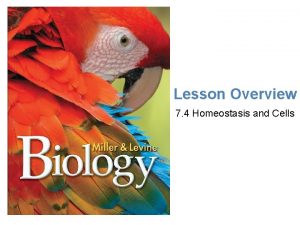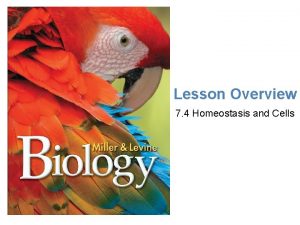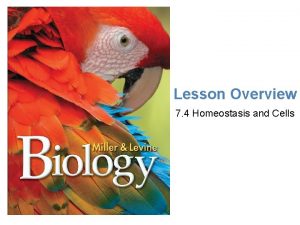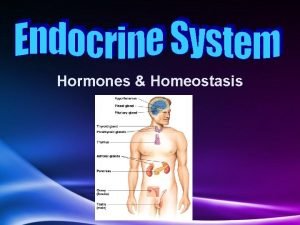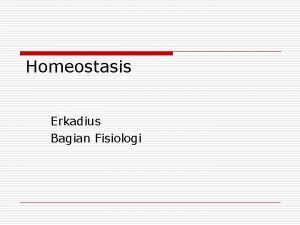Lesson Overview Homeostasis and Cells 7 4 Homeostasis



















- Slides: 19

Lesson Overview Homeostasis and Cells 7. 4 Homeostasis and Cells

Lesson Overview Homeostasis and Cells The Cell as an Organism How do individual cells maintain homeostasis? To maintain homeostasis, unicellular organisms grow, respond to the environment, transform energy, and reproduce.

Lesson Overview Homeostasis and Cells The Cell as an Organism A single-celled, or unicellular, organism does everything you would expect a living thing to do. Just like other living things, unicellular organisms must achieve homeostasis, relatively constant internal physical and chemical conditions. To maintain homeostasis, unicellular organisms grow, respond to the environment, transform energy, and reproduce.

Lesson Overview Homeostasis and Cells The Cell as an Organism In terms of their numbers, unicellular organisms dominate life on Earth. Unicellular organisms include both prokaryotes and eukaryotes. Prokaryotes, especially bacteria, are remarkably adaptable and live almost everywhere—in the soil, on leaves, in the ocean, in the air, and even within the human body.

Lesson Overview Homeostasis and Cells The Cell as an Organism Many eukaryotes also spend their lives as single cells. Some types of algae, which contain chloroplasts and are found in oceans, lakes, and streams around the world, are single celled. Yeasts, or unicellular fungi, are also widespread. Yeasts play an important role in breaking down complex nutrients, which makes them available for other organisms.

Lesson Overview Homeostasis and Cells The Cell as an Organism Whether a prokaryote or a eukaryote, homeostasis is an issue for each unicellular organism. Every unicellular organism needs to find sources of energy or food, to keep concentrations of water and minerals within certain levels, and to respond quickly to changes in its environment.

Lesson Overview Homeostasis and Cells Multicellular Life How do the cells of multicellular organisms work together to maintain homeostasis? The cells of multicellular organisms become specialized for particular tasks and communicate with one another to maintain homeostasis.

Lesson Overview Homeostasis and Cells Multicellular Life The cells of multicellular organisms are interdependent, and like the members of a successful baseball team, they work together. In baseball, players take on a particular role, such as pitcher, catcher, infielder, or outfielder. Messages and signals are sent and understood by teammates and coaches to play the game effectively. Cells in a multicellular organism work the same way. The cells of multicellular organisms become specialized for particular tasks and communicate with one another in order to maintain homeostasis.

Lesson Overview Homeostasis and Cells Cell Specialization The cells of multicellular organisms are specialized, with different cell types playing different roles. Some cells are specialized to move, others to react to the environment, and still others to produce substances that the organism needs. No matter what the role, each specialized cell contributes to the overall homeostasis of the organism.

Lesson Overview Homeostasis and Cells Specialized Animal Cells Particles of dust, smoke, and bacteria are part of even the cleanest air. Specialized animal cells act like street sweepers to keep the particles out of the lungs. These cells are full of mitochondria, which provide a steady supply of the ATP that powers the cilia on their upper surfaces.

Lesson Overview Homeostasis and Cells Specialized Plant Cells Pollen grains are highly specialized cells that are tiny and light, with thick cell walls to protect the cell’s contents. Pine pollen grains have two tiny wings that enable the slightest breeze to carry them great distances.

Lesson Overview Homeostasis and Cells Levels of Organization The specialized cells of multicellular organisms are organized into tissues, then into organs, and finally into organ systems.

Lesson Overview Homeostasis and Cells Levels of Organization A tissue is a group of similar cells that performs a particular function.

Lesson Overview Homeostasis and Cells Levels of Organization To perform complicated tasks, many groups of tissues work together as an organ. Each type of tissue performs an essential task to help the organ function. In most cases, an organ completes a series of specialized tasks.

Lesson Overview Homeostasis and Cells Levels of Organization A group of organs that work together to perform a specific function is called an organ system. For example, the stomach, pancreas, and intestines work together as the digestive system.

Lesson Overview Homeostasis and Cells Levels of Organization The organization of the body’s cells into tissues, organs, and organ systems creates a division of labor among those cells that allows the organism to maintain homeostasis.

Lesson Overview Homeostasis and Cells Cellular Communication Cells in a large organism communicate by means of chemical signals that are passed from one cell to another. These cellular signals can speed up or slow down the activities of the cells that receive them, and can cause a cell to change what it is doing.

Lesson Overview Homeostasis and Cells Cellular Communication Some cells form connections, or cellular junctions, to neighboring cells. Some junctions hold cells firmly together.

Lesson Overview Homeostasis and Cells Cellular Communication Other junctions allow small molecules carrying chemical messages to pass directly from one cell to the next. To respond to one of these chemical signals, a cell must have a receptor to which the signaling molecule can bind. Sometimes these receptors are on the cell membrane, although the receptors for certain types of signals are inside the cytoplasm. The chemical signals sent by various types of cells can cause important changes in cellular activity. For example, such junctions enable the cells of the heart muscle to contract in a coordinated fashion.
 Bioflix activity homeostasis hormones and homeostasis
Bioflix activity homeostasis hormones and homeostasis Bioflix activity homeostasis high blood glucose
Bioflix activity homeostasis high blood glucose How do cells maintain homeostasis
How do cells maintain homeostasis How do cells maintain homeostasis
How do cells maintain homeostasis Prosmosis
Prosmosis Plants cells _________ water and start to _w_ ___ ___ ___.
Plants cells _________ water and start to _w_ ___ ___ ___. Waters view
Waters view Chlorocruorin
Chlorocruorin Comparing plant and animal cells venn diagram
Comparing plant and animal cells venn diagram Masses of cells form and steal nutrients from healthy cells
Masses of cells form and steal nutrients from healthy cells Tubular lumen
Tubular lumen Thyroid gland
Thyroid gland Gametic cells vs somatic cells
Gametic cells vs somatic cells Somatic cells vs germ cells
Somatic cells vs germ cells Prokaryote vs eukaryote
Prokaryote vs eukaryote Prokaryotic cells vs eukaryotic cells venn diagram
Prokaryotic cells vs eukaryotic cells venn diagram Organelle trail
Organelle trail Pseudostratified vs simple columnar
Pseudostratified vs simple columnar What animals have prokaryotic cells
What animals have prokaryotic cells Which compares prokaryotes and eukaryotes
Which compares prokaryotes and eukaryotes


